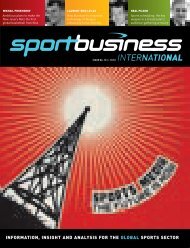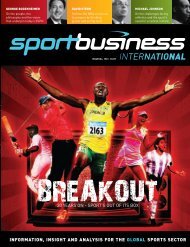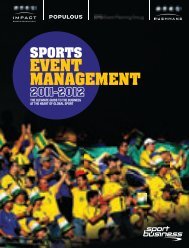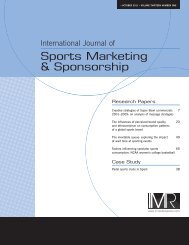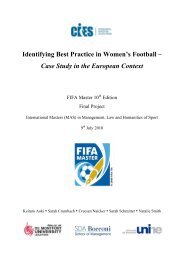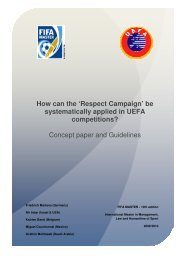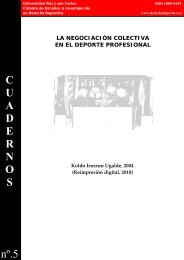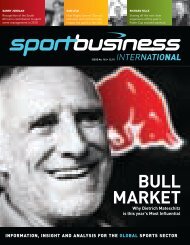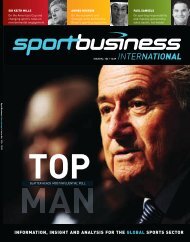Sports Marketing & Sponsorship - FIFA/CIES International University ...
Sports Marketing & Sponsorship - FIFA/CIES International University ...
Sports Marketing & Sponsorship - FIFA/CIES International University ...
- No tags were found...
Create successful ePaper yourself
Turn your PDF publications into a flip-book with our unique Google optimized e-Paper software.
(Bourgeon & Bouchet, 2001). It has also identifiedyoung an fans and females – women and girls.The brand was positioned in opposition to its mainrugby union competitors located in the south-west ofFrance and the club has developed a modern,fashionable brand image. <strong>Marketing</strong> was conducted inaccordance within the overall strategy and thesegments SF Paris targeted. The club focused onoffering highly entertaining games with numerousperipheral elements at very cheap prices (starting from5 euros), developing the merchandising throughinnovative replica shirts and extending the brand withinnovative merchandise such as cosmetic products.This strategy has important similarities withAmerican professional sport and is consideredinnovative when compared to European practices.Indeed, European rugby union clubs, and professionalsport clubs in general, concentrate mainly onattracting the best players in order to secure as manyvictories and trophies as possible. These, in turn,enhance customer loyalty, which then guaranteessteady financial income (Morgan, 2002).Moreover, Harris and Jenkins (2001) highlighted thelack of strategic marketing in English and Welsh rugbyunion clubs, which favours the reproduction oftraditional practices.The aim of this analysis is not to encouragereplication of the SF Paris strategy because it isstrongly related to the sports club’s identity. Instead, itis to emphasise the essential role of marketing strategyfor professional sports clubs and to encourageinnovation in the increasingly competitive professionalsport and entertainment sectors, which are, more thanever, being driven by globalisation.BackgroundOn 27 February 2007, Stade Français Paris beatStade Toulousain 22 to 20 in a game that set a newworld record, not for its score but for attendance at thestadium (Jackson, 2007) – 79,741 spectators for aFrench premier league regular season matchconstitutes a world record for rugby union and also aFrench national record for any sport. The reasons whythis event is so interesting are based on the context inwhich it was achieved. This was not the result of aregular on-field success, but a result of the role ofmarketing in attracting such a crowd. Incidentally, theattendance figure was not a one-off. Since the2004-05 season, SF Paris has on several occasionssucceeded in gaining significantly large crowdsthrough marketing initiatives. Crowds in excess ofaround 70,000 or 40,000 (depending on the capacityof the stadium) have been achieved regularly. Theseare exceptional performances considering both thegeneral interest in rugby union in France and that theclub’s regular home stadium has only 10,500 seats(Ligue Nationale de Rugby; LNR).ObjectiveThe objective of this paper is to highlight thesuccessful marketing management of SF Paris inattracting big crowds and developing strong brandequity. Obviously, investigating a posteriori the successof a company or a brand is always a difficult exercisebecause analysts can never be entirely sure about theauthenticity of the managerial rationale that leads tosuccess. However, in our case, we think that themarketing strategy that we present was wellconsidered and intentional, mainly because of thepersonality and the professional background of thechairman of the club, Max Guazzini. This formerchairman of a successful private French radio stationtook over the presidency of Stade Français in 1992and was the catalyst for the development of the club,indeed some might even say for the overallrejuvenation of French professional rugby.Therefore, we will present the strategic plans andmarketing initiatives SF Paris implemented to build itsworld record attendance and strong brand equity.Finally, a comparison with other European clubs willbe made to show why this case is unique and how itcould be replicated.CASE STUDY● APRIL 2009 ● <strong>International</strong> Journal of <strong>Sports</strong> <strong>Marketing</strong> & <strong>Sponsorship</strong>253



